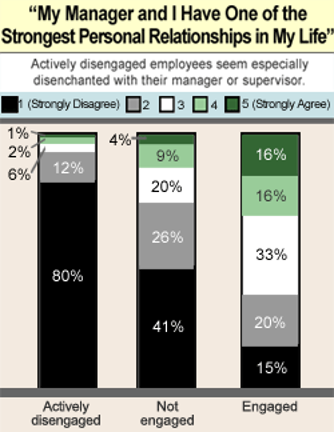Turnover isn't just an HR issue – it’s a leadership challenge. Learn six research-backed strategies to shift executive conversations and make retention a business priority in 2025.
From Stagnation to Success: You Can Improve Employee Engagement

During the first year of the pandemic, I wrote a blog that contained the most interesting employee engagement data I had ever seen at that time showing that employee engagement roller-coastered to its highest-point ever and then immediately tumbled to its greatest decline…all within a matter of weeks. Gallup’s explanation was 100%-focused on the events of our wacky 2020 times…our pandemic, social unrest, “The Great Resignation”, and more.
Unfortunately, today’s engagement still remains low. I vowed then to tell you how to improve employee engagement moving forward to overcome Gallup’s ongoing reporting that that just about one-third of our U.S. employees are engaged and that engagement has stayed essentially the same for years and years, long before the pandemic, and still to this day.
Why Hasn’t Employee Engagement Improved?
Let’s start with why most engagement strategies fail:
1) Reliance on employee surveys. By way of their required anonymity, surveys give broad trends vs individual employee responses meaning the inputs of your best performers and those you will terminate tomorrow gain equal weight. Surveys provide data but not solutions, and few organizations get the solutions right.
2) Using external benchmarks to judge internal data. Most surveys provide external benchmarks to compare results to. External benchmarks are momentum killers because most organizations are happy to be in the middle of the pack. And benchmarks which are so valuable in other areas of organizations are downers here because the easy cop-out is to say if other companies can’t fix this, we can’t fix it either. For most executives and many HR professionals, their reaction to their “average” engagement score compared to benchmarks is the same as their reaction to rush-hour traffic, something we cannot change and therefore we must work around. “The benchmark proves we can’t do better.”
Let’s pause here for a moment. Can you imagine your CEO thinking it is OK to be average in sales or service? Thinking that if competitors can’t do these things better then we can’t do them better either? This tells you the true state of engagement today, and why it hasn’t changed in twenty years.
Can Engagement Scores Really Be Raised?
Absolutely! We have dozens of clients who not only improved their employee engagement and improved their employee retention by 20% or more, they did it during the worst of the pandemic’s trials. First, educate your top team that engagement is more than a score. A few years ago I published a paper on employee engagement’s correlations to productivity and profitability that is still relevant today and may be a helpful place to start.
The time has come for CFOs to see employee retention and engagement as areas of both high cost and high opportunity for increased revenue. If your management meetings include CFOs reporting on essential operations performance against metrics while HR reports on engagement and retention, ask your CFO to report all of the data including engagement and retention. Otherwise, engagement and retention are seen as second-class metrics, less important than the operations metrics for which they might have the greatest influence. What influences operations performance more than the people who do the jobs there?
Second, share this Gallup study with your executive team regarding how much each individual leader impacts her team’s engagement.

Start by telling them the statement at the top is extreme, that Gallup researchers likely debated about whether to ask a question that included terms like “strongest personal relationships” when discussing employees’ bosses. But they did. And the outcome on a scale of 1 to 5 with 5 being high is 65% of the engaged employees…the ones we most need to keep…scored their manager relationships a 3 or above. And for the employees who are actively disengaged…the sabotagers…a full 92% scored their manager relationships a 1 or a 2.
Nothing Improves Employee Engagement more than Stay Interviews
The you-can’t-miss-it conclusion is clear. Solving employee engagement must be done on a boss-employee level, one-on-one, and not with one-size-fits-all programs. The joke line here is no one stays longer or works harder for pet insurance.
One easy way to think about improving employee engagement…and for sure employee retention…is to ask what do your employees talk about over dinner. When someone asks, “How was your day, dear?”, employees focus on three topics…bosses, colleagues, and duties. There are zero one-size-fits-all programs that address these subjects because each person’s circumstances are unique.
In my book titled HR’s Greatest Challenge, I presented 25 studies proving the #1 reason employees stay/leave or engage/disengage is how much they trust their boss. This means every post-survey “solution” you implement matters less than bosses building trust. So yoga classes, company clocks, events with food…put your own list here…all matter not just less but far less than employees trusting their bosses.
Now it is easy to see why the U.S. spends $1.53 billion each year to improve engagement but engagement has not improved, right?
So if “boss trust” is the driving force for retention, how does each boss build trust? The obvious answer then becomes by making each employee’s day better…and not worse. Stay Interviews are a major part of the solution we offer clients which I invented with a book in 2012. The concept is simple but smart, that if employee turnover is based on how much employees trust their boss, then those bosses need an interactive way to build trust. And that interactive way must be based on topics each manager can control. So our five questions, the SI 5 as we call them in-house, must address day-to-day issues that a first-line manager can change.
Our research tells us these are the right questions to ask…to learn what your employees think about during those first two hours after work and what they talk about over dinner. Nearly all day-to-day good things/bad things that are within their manager’s control.
The real proof is our client managers ask these questions, then listen, take notes, and probe to learn more by converting five questions to twenty or more. Then they build individualized stay plans for each employee. And their overall company turnover decreases by twenty percent or more.
Let’s have one more pause moment here. Does any metric across your entire company matter more than employee engagement? Or employee retention? Unless you are creating revenue entirely without employees, the answer is no.
You Can Cut Turnover by 20% or More, No Matter Your Industry
There is an established solution for employee turnover…start here to learn our comprehensive turnover solution, and watch the 2-minute video to open your eyes to fresh thinking for cutting turnover 20% and more. Then schedule a conversation with me at DFinnegan@C-SuiteAnalytics.com.



